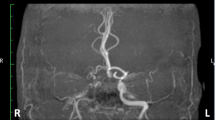Summary
The authors carried out a Matas test with a regional cerebral blood flow (rCBF) study using H2 15O positron emission tomography (PET) for three cases of large internal carotid artery aneurysms. There is a likely correlation between the cerebral blood flow (CBF) reduction rate obtained by PET, and the mean stump pressure available from a conventional balloon occlusion test. The advantages of this noninvasive and quantitative method are presented in comparison with other methods.
Similar content being viewed by others
References
Creutzig H, Schober O, Gielow P, Friedrich R, Becker H, Dietz H, Hundeshagen H (1986) Cerebral dynamics of N-isopropyl-(123I)p-iodoamphetamine. J Nucl Med 27: 178–183
Eckard DA, Purdy PD, Bonte FJ (1992) Temporary balloon occlusion of the carotid artery combined with brain blood flow imaging as a test to predict tolerance prior to permanent carotid sacrifice. AJNR 13: 1565–1569
Erba SM, Horton JA, Latchaw RE, Yonas H, Sekhar L, Schramm V, Pentheny S (1988) Balloon test occlusion of the internal carotid artery with stable xenon/CT cerebral blood flow imaging. AJNR 9: 533–538
Fox AJ, Vinuela F, Pelz DM, Peerless SJ, Ferguson GG, Drake CG, Debrun G (1987) Use of detachable balloons for proximal artery occlusion in the treatment of unclippable cerebral aneurysms. J Neurosurg 66: 40–46
Jannet WB, Harper AM, Gillespie FC (1966) Measurement of regional cerebral blood-flow during carotid ligation. Lancet 2: 1162–1163
Herscovitch P, Markham J, Raichle ME (1983) Brain blood flow measured with intravenous H2 15O. I. Theory and error analysis. J Nucl Med 24: 782–789
Kanno I, Miura S, Murakami M, Iida H, Takahashi K, Shishido F, Uemura K (1987) Cerebral blood flow measurement using H2I5O intravenous injection and positron emission tomography. Description of implementation and applications to cerebrovascular reactivity measurement. Brain and Nerve (Tokyo) 39: 535–542 (Jpn)
Komiyama M, Khosla VK, Tamura K, Nagata Y, Baba M (1992) A provocative internal carotid artery balloon occlusion test with99mTc-HM-PAO CBF mapping. Report of three cases. Neurol Med Chir (Tokyo) 32: 747–752
Lear JL (1987) Tc99m-hexamethylpropyleneamine oxime as a tracer for LCBF. Evaluation by triple label digital quantitative autoradiography. J Cereb Blood Flow Metab 7 [Suppl 1]: S561
Matas R (1911) Testing the efficiency of the collateral circulation as a preliminary to the occlusion of the great surgical arteries. Ann Surg 53: 1–43
Mathews D, Walker BS, Purdy PD, Batjer H, Allen BC, Eckard DA, Devous MD, Bonte FJ (1993) Brain blood flow SPECT in temporary balloon occlusion of carotid and intracerebral arteries. J Nucl Med 34: 1239–1243
Matsuda H, Higashy S, Asli IN, Eftekhari M, Esmaili J, Seki H, Tsuji S, Oba H, Imai K, Terada H, Sumiya H, Hisada K (1988) Evaluation of cerebral collateral circulation by technetium-99 m HM-PAO brain SPECT during Matas test. Report of three cases. J Nucl Med 29: 1724–1729
Matthew E, Andreason P, Carson RE, Herscovitch P, Pettigrew K, Cohen R, King C, Johanson CE, Paul SM (1993) Reproducibility of resting cerebral blood flow measurements with H2 15O positron emission tomography in humans. J Cereb Blood Flow Metabol 13: 748–754
Miller JD, Jawad K, Jennett B (1977) Safety of carotid ligation and its role in the management of intracranial aneurysms. J Neurol Neurosurg Psychiatry 40: 64–74
Raichle ME, Martin WRW, Herscovitch P, Mintum MA, Markham J (1983) Brain blood flow measured with intravenous H2 15O. II. Implementation and validation. J Nucl Med 24: 790–798
Yasui T, Yagura H, Fu Y, Nagata Y, Tamura K, Hakuba A (1992) Ischemic complications following patient artery occlusion with detachable balloons in the tratment of large carotid aneurysms. Effectiveness of99mTc-HMPAO SPECT and importance of postoperative management. Neurological Surgery (Tokyo) 20: 1173–1178 (Jpn)
Author information
Authors and Affiliations
Rights and permissions
About this article
Cite this article
Katano, H., Nagai, H., Mase, M. et al. Measurement of regional cerebral blood flow with H2 15O positron emission tomography during matas test. Acta neurochir 135, 70–77 (1995). https://doi.org/10.1007/BF02307417
Issue Date:
DOI: https://doi.org/10.1007/BF02307417



